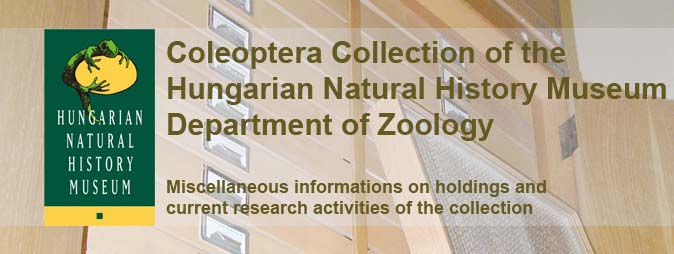
MENU BAR
The most remarkable parts of the Collection
Perhaps the most important part (although not a separated entity) of the Coleoptera Collection is the Reitter Collection which contains authoritatively identified specimens of 30,000 Palearctic beetle taxa, including types of 5,000 species, subspecies and varieties. (Most scientific enquiries are directed toward the Reitter's types. However, in contrast with the general belief not all Reitter's types are found in Budapest.)
The collection of darkling beetles (Tenebrionidae) housed in our Museum is of great importance for any entomologist working on or interested in this family of beetles. The accomplishment of this collection is above all due to the scientific activity of Zoltán Kaszab, who was, in his time, probably more familiar with the world tenebrionid fauna than any other person. The collection contains nearly 12,000 species with more than 5,100 species or subspecies being represented by type specimens. It is rich in species from all major zoogeographical regions, but the species representation of the Palaearctic region (i.e. the vast area embracing Europe, North Africa and temperate Asia) is practically complete. Beside species described by Zoltán Kaszab himself, types designated by Edmund Reitter, Hans Gebien, Sebastian Endrődy-Younga, Carl Koch and a number of other authors are also available. The collections of blister beetles (Meloidae), the rhinoceros beetles (Dynastinae of Scarabaeidae) and the blind scavenger beetles (Bathyscinae of Leiodidae) are also remarkable.
Location, storage and arrangement
The Coleoptera Collection is housed on the second floor of the central building (Baross u. 13, 8th district, Budapest). About 98 percent of the specimens are stored in more than 8000 glass-lidded drawers of 40 × 50 cm, in wooden cabinets of two sizes. The rest is temporarily kept in cardboard storeboxes.
The material from the Carpathian Basin is separated from the material from other areas. Within these two parts the collection is arranged systematically, and in the case of the larger families the species are grouped according to the zoogeographical regions. Types are incorporated into the identified material. Only the Mongolian material comprising about 200,000 specimens collected by Zoltán Kaszab between 1963 and 1968 is kept as a separate entity.
Size and geographical range
The Coleoptera Collection is the largest of the collections in the Department of Zoology. The number of specimens is over an estimated 3 million representing about 100,000 species and including 12,000 type specimens. Two-thirds of the material is from the Carpathian Basin (mainly from the present-day Hungary) and the species representation of the Hungarian beetle fauna is practically complete. Therefore, the collection serves as National Reference Collection for Coleoptera. The remaining one-third is from other parts of the world. The coverage is worldwide; however, some geographical areas are better represented (e.g. much of the Palearctic region, New Guinea, Southeast Asia, certain parts of Africa and Australia) and others less so (e.g. most parts of the New World). An estimated 75 percent of the specimens have been identified, while the rest has been sorted to at least family level. Only the most recent acquisitions are unprepared or prepared but unsorted.
The collection is supplemented with about 1100 scientific books and 20,000 reprints on Coleoptera.
Catalogues
A typewritten old catalogue prepared by Zoltán Kaszab lists the types existed in the collection in 1950. Another list contains the extra-Hungarian genera of the Curculionoidea indicating the serial number of cabinets and drawers in which the given genera are found. A similar list is available for the Hungarian genera nad subgenera of Aleocharinae. Data of about 12,000 specimens collected in the Szigetköz area (NW Hungary) are found in a database. A typewritten list contains species and subspecies of Cicindelinae, Carabini and Cychrini (Carabidae) represented in the collection. Computerised lists of types of certain groups (e.g. Histeridae, Rutelinae) have also been completed. These catalogues and lists can be studied on the spot only.